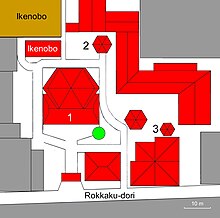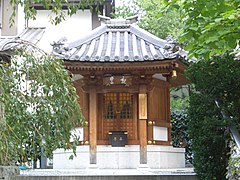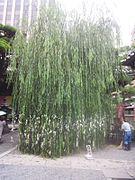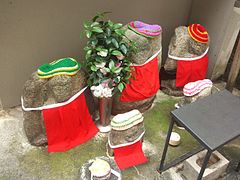Rokkaku-do
The Rokkaku-dō ( Japanese 六角 堂 ) is a Buddhist temple in the Nakagyō-ku district of the city of Kyoto in Japan . The temple name means roughly hexagonal hall and alludes to the shape of the main hall of the temple. The official name of the temple is Chōhō-ji ( 頂 法 寺 ), which carries the Go Shiun-zan (紫雲山). The temple is associated with the Tendai-shu belief . The main image of the temple is a statue of Kannon with a wish-fulfilling jewel. The Rokkaku-do is the 18th temple on the Saigoku pilgrimage route ( 西 国 三十 三 箇 所 , Saigoku sanjūsankasho ).
overview
According to temple tradition, the Prince Regent Shōtoku should have founded the Rokkaku-dō in 587. The first abbot was the retired diplomat Ono no Imoko . However, it is more likely that it was founded during the early Heian period .
The Rokkaku-do played a major role in the emergence of the Buddhist faith Jōdo-Shinshū . Its founder Shinran is said to have retired to Rokkaku-do for a hundred days; on the 95th day Shōtoku appeared to him in a dream and recommended him to become a student of the monk Honen .
The Rokkaku-dō is considered to be the temple where monks first created flower arrangements as temple decorations. The art of flower arranging Ikebana developed from this. The temple tradition traces this art back to the first abbot Ono no Imoko, who got to know elaborate flower arrangements on his missions in China. His hut at the lake ( 池 坊 , Ike no bō ) was the name giving the Ikenobō direction of Ikebana. In 1450 Ikenobō Senkei founded the first ikebana school in the true sense of the word in Rokkaku-dō.
investment
The hexagonal Rokkaku-dō (1 in the plan) is the main hall of the temple. After the main hall, which dates from 1125, was destroyed by fire, the current building was built in a similar style in 1877. In front of the main hall is the Rokkaku pasture (六角 柳; green in the plan). To the north is a small hexagonal pavilion, the Taishi-dō (太子 堂; 2), which is dedicated to Shōtoku Taishi . In the area of the abbot and monk's quarters there is another hexagonal pavilion, the Shinran-dō (親 鸞 堂, 3), it is dedicated to Shinran. In the entrance area there is a small pavilion called Fudō-dō (不 動 堂) on the left.
The “navel stone” ( へ そ 石 , heso ishi) is embedded in the pavement in front of the main hall . According to legendary tradition, it is said to be a foundation stone of the original temple, which also formed the center of medieval Kyoto. The current location of the temple building is justified by the fact that Kannon complied with an imperial request and miraculously moved the building further north.
Temple treasures
The temple treasures include a wooden, standing Bishamon (木造 毘 沙門 天 立 aus) from the Heian period and a picture entitled "Ikenobo Senkō's Flower Arrangement" (池 坊 専 好 立 花 図, Ikenobo Senkō rikka-zu). Both are registered as an Important Cultural Property of Japan .
photos
16 arhat
literature
- Kyoto-fu rekishi isan kenkyukai (Ed.): Rokkaku-do . In: Kyoto-fu no rekishi sampo (jo). Yamakawa Shuppan, 2011. ISBN 978-4-634-24626-3 . Pp. 63, 64.
- Patricia Frame Rugola: The Saikoku Kannon Pilgrimage Route. Dissertation, Ohio State University, 1986.
- Valeria Jana Schwanitz and August Wierling: Saigoku - Out and about in Japan's western lands. Manpuku-Verlag, Potsdam, 2012, ISBN 978-3-9815168-0-7 .
Web links
- Ikenobo School website on Rokkaku-do (Japanese)
Individual evidence
- ^ Ponsonby-Fane, Richard Arthur Brabazon: Kyoto: The Old Capital of Japan, 794-1869 . 1956, p. 110.
Coordinates: 35 ° 0 ′ 26 ″ N , 135 ° 45 ′ 37 ″ E










